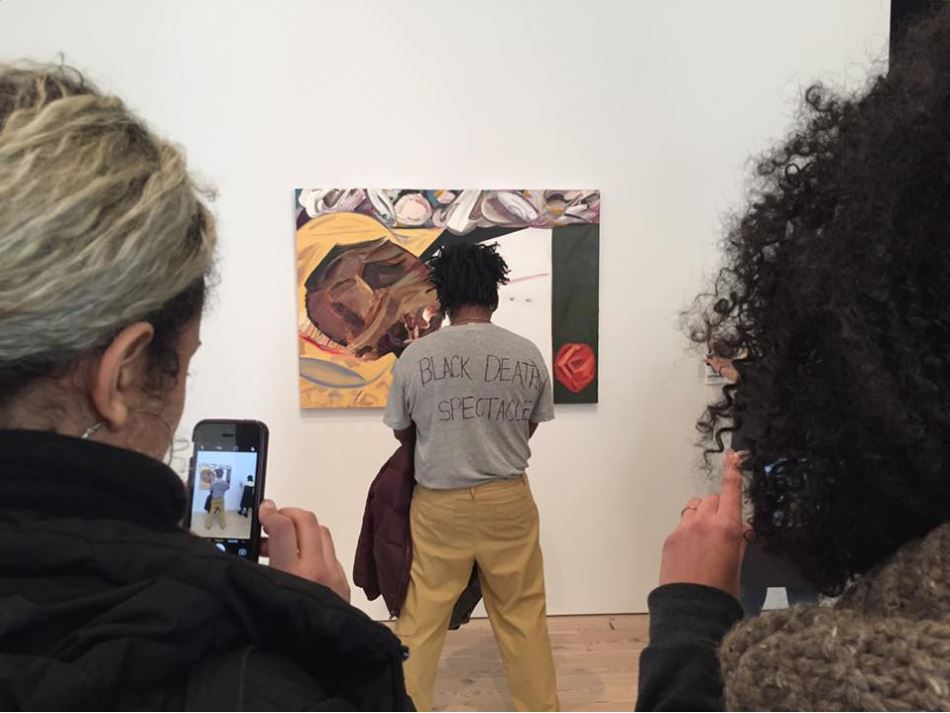Art World
Social Media Erupts as the Art World Splits in Two Over Dana Schutz Controversy
The art world is not a monolith, social media posts reveal.

The art world is not a monolith, social media posts reveal.

Brian Boucher

It all started on Facebook.
One week ago, the very day the Whitney Biennial opened to the public, artist Parker Bright mounted a protest, via Facebook live video, against Dana Schutz’s painting of a murdered Emmett Till in his coffin. He only knew of the painting in the first place, writer Antwaun Sargeant has pointed out, because of images on social media.
Posted by Parker Bright on Friday, March 17, 2017
Writer Hannah Black would follow up with an open letter, posted on Facebook but since removed, calling for the painting’s removal and destruction.
With that, a searing debate opened on social media over subjects like white violence, white privilege, black suffering, the value of art, who can speak for whom, and who can comment on whose experience. Art-world observers lined up on opposing sides of the protest. Some claim an artist’s right to depict any subject they choose, and rail against what they call censorship; others point out that white privilege and the appropriation of black experience is as old as America itself, and inherently pernicious.
In posting Josephine Livingstone and Lovia Gyarkye’s argument against Schutz’s painting that was published in The New Republic, retired art dealer Zach Feuer (who once represented Schutz) said that the debate had been very educational, not least in pointing out what he considers the narrow-mindedness of some of his colleagues in the art field.
The most surprising thing about this for me has been learning that white art-world peers, who I assumed had some social…
Posted by Zach Feuer on Thursday, March 23, 2017
Digital art conservator Ben Fino-Radin called on white people in the art world to open their ears.
Dear White People of the Art World: now is a VERY good time to shut up and listen. #DanaSchutz
— ツ Ben Fino-Radin (@benfinoradin) March 22, 2017
Harking back to the 1993 Whitney Biennial, tweeter @JGLuzifer offered an updated version of Daniel Joseph Martinez’s iconic series of admission badges from that year that stated “I can’t imagine ever wanting to be white.” It was that very biennial, curated by Elisabeth Sussman in the midst of the “culture wars,” that marked the emergence of identity politics on the stage of the Whitney Biennial itself, and in the art conversation at large.
I CAN'T after Daniel Martinez @whitneymuseum @kg_ubu #whitneybiennial #EmmettTill #DanaSchutz pic.twitter.com/rd39l9wxAk
— JGLÜZ (@JGLuzifer) March 23, 2017
Less historically referential and more purely outraged was artist Rafia Santana’s take: burn the painting, she says.
Burn that #DanaSchutz painting of Emmet Till's open casket. White woman profiting off of black murder caused by a white woman #wow pic.twitter.com/7o5XqSmQ14
— ?HARD•TWEE? (@RAF_i_A) March 16, 2017
In an emoji-rich graphic, an Instagrammer dismisssed the notion that the world ever needed the painting.
By Thursday, hoaxers had gotten involved, penning a fake letter, supposedly from Schutz, calling for the painting to be removed in compliance with Black’s petition. Pastiche Lumumba opined that the stunt only highlighted the poor handling of the fracas on the part of the artist and the museum.
Somebody wrote the letter that Dana Schutz should have written and it got posted, which is hilarious because it just makes her and the museum look even whacker. The fake news is better than the real news.
Posted by Pastiche Lumumba on Thursday, March 23, 2017
Lumumba also came out with a very specific set of instructions for how the Whitney could redress the situation.
Since people love to ask what they should do.
Posted by Pastiche Lumumba on Wednesday, March 22, 2017
Others joined in the criticism of Schutz, with writer Katy Diamond Hamer, in a lengthy Instagram post, calling out what she sees as the shortcomings of Schutz’s project.
https://www.instagram.com/p/BR9PN3HA4z7/
It’s not just Schutz, but also Biennial curators Christopher Y. Lew and Mia Locks, who have come in for criticism, as evidenced by this tough post from artist and critic Pedro Velez.
My respects to Dana Shutz. Shame on the coward curatorial class. Shame on the white, dominant art press. Schutz taught…
Posted by Pedro R Velez on Thursday, March 23, 2017
But the art world, and even the black community within the art world, does not speak with one voice, as an Instagram post by Kara Walker, whose own work has been at the center of controversy over race and representation, pointed out.
https://www.instagram.com/p/BR-3iH5l0ZW/
When critic Jerry Saltz reposted Walker’s Instagram post, artist Marilyn Minter came out against the criticisms of Schutz.

Artist Kristian Kahn, similarly, found the political left just as guilty in calls for censorship as Republican Mayor Rudolph Giuliani was when he railed against Chris Ofili’s rendition of the Virgin Mary, a lightning rod at the 1997 “Sensation”exhibition at the Brooklyn Museum.
https://www.instagram.com/p/BR8oxI9gatC/
Performance artist Clifford Owens likewise came out against what he dubbed censorship.
Feelings are not always facts. What about other problematic and exploitative representations of black/brown bodies and…
Posted by Clifford Owens on Tuesday, March 21, 2017
Referring to Hannah Black’s open letter, which accused Schutz of trying to profit from tragedy, Chicago artist Robert Burnier voiced skepticism about that critique, while also suggesting that Schutz could have achieved a symbolic atonement with a different kind of depiction of Till.

Social media reaction would be nothing without arch humor, and Raymond Boisjoly cutely pointed to the controversy at the 2014 Biennial, when white artist Joe Scanlan’s work impersonating a black, female artist named Donelle Woolford sparked debate and protest.
Has anybody asked Donelle Woolford to comment on this fake letter?
Posted by Raymond Boisjoly on Thursday, March 23, 2017
Writer John Arthur Peetz had the final word with a meme to bind them all, showing everyone involved ducking for cover as an out-of-control ball speeds their way.